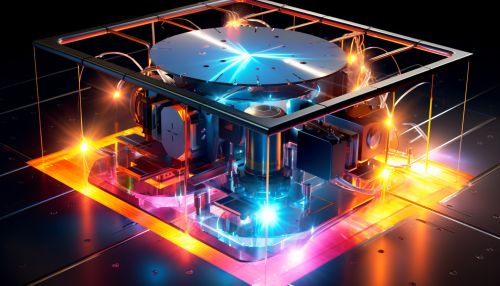Photonic Quantum Computing
Introduction
Photonic quantum computing is a branch of quantum computing that utilizes photons as the primary information carriers. The field is based on the principles of quantum mechanics, quantum information theory, and quantum optics. The unique properties of photons, such as their ability to exhibit superposition and entanglement, make them ideal for quantum computations.


Principles of Photonic Quantum Computing
Photonic quantum computing leverages the principles of quantum mechanics. These principles include superposition, entanglement, and the ability to perform operations on quantum bits, or qubits, which are the basic units of quantum information.
Quantum Superposition
Quantum superposition is a fundamental concept in quantum mechanics that allows particles to exist in multiple states simultaneously. In the context of photonic quantum computing, a photon can be in a superposition of multiple polarization states, which can be used to represent a qubit.
Quantum Entanglement
Quantum entanglement is another key principle in quantum mechanics. It refers to a phenomenon where two or more particles become linked and the state of one particle instantly influences the state of the other, regardless of the distance between them. In photonic quantum computing, entangled photons can be used to perform complex computations more efficiently than classical computing methods.
Qubits
In photonic quantum computing, qubits are represented by the polarization states of photons. Unlike classical bits, which can be either 0 or 1, qubits can be in a superposition of states, allowing them to perform multiple calculations simultaneously.
Photonic Quantum Computing Models
There are several models of photonic quantum computing, each with its own set of advantages and challenges. These include the quantum circuit model, the one-way quantum computer, and the measurement-based quantum computation model.
Quantum Circuit Model
The quantum circuit model is a theoretical model for quantum computing where computations are performed by applying a sequence of quantum gates to an array of qubits. In a photonic quantum circuit, these gates are implemented using linear optical elements such as beam splitters and phase shifters.
One-Way Quantum Computer
The one-way quantum computer, also known as the measurement-based quantum computer, is a model of quantum computing where computations are performed by making a sequence of measurements on a highly entangled state of photons, known as a quantum state or cluster state.
Measurement-Based Quantum Computation
Measurement-based quantum computation is a model of quantum computing that generalizes the one-way quantum computer. In this model, computations are performed by making a sequence of adaptive measurements on a multi-photon entangled state.
Advantages and Challenges of Photonic Quantum Computing
Photonic quantum computing offers several advantages over other forms of quantum computing. However, it also faces several challenges that must be overcome to realize its full potential.
Advantages
One of the primary advantages of photonic quantum computing is that photons are robust against many types of environmental noise, which can cause quantum decoherence and loss of information. Additionally, photons can be easily manipulated and controlled with high precision using existing optical technologies.
Challenges
Despite its advantages, photonic quantum computing also faces several challenges. These include the difficulty of generating and maintaining entangled photon states, the need for highly efficient single-photon detectors, and the requirement for scalable and practical photonic quantum computing architectures.
Future Prospects
The field of photonic quantum computing is still in its early stages, but it holds great promise for the future. Advances in photonic technologies and quantum algorithms are expected to drive the development of more powerful and efficient photonic quantum computers.
